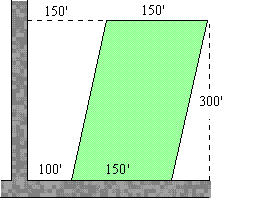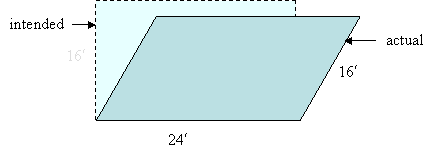|
Compute u×v and v×u. Also, show that u and v are orthogonal to u×v.
|
Sketch the triangle formed by the three points P1, P2 and P3 and then find its area.
|
Sketch the parallelepiped spanned by u, v, and w assuming all vectors have initial points at the origin. Then calculate the volume of the parallelepiped.
|
27. Let u = áu1,u2,u3 ñ and let v = áv1,v2,v3 ñ . Use (2) to show that v×u is the same as -( u×v) .
28. Show that
|
29. Let u = áu1,u2,u3 ñ , v = áv1,v2,v3 ñ , and a = áa1,a2,a3 ñ . Show that
|
30. Let u = áu1,u2,u3 ñ and v = áv1,v2,v3 ñ , and let k be a number. Show that
|
31. Use the x' y' coordinate system to show that if
u and v are 3-dimensional vectors, then u · v = ||u|| ||v|| cos(q). How would you use projections to
define the y'-axis in the x' y' coordinate system?
|
32. Let u and v be in
the polar forms
(in the x' y' coordinate system in exercise 31) given by
|
33. Jane buys a lot that is 150 feet wide across the front and back, and the back right corner is 300 feet along a perpendicular from the road fronting the property. The front left corner is 100 feet from a road which intersects the fronting road at a right angle, and the back left corner is 150 feet from that same road.

34. Roy intended to pour a 24¢ by 16¢ rectangular concrete patio, but he didn't check closely for square and instead ended up with a deck in the form shown below

Which has more area, the patio Roy intended to build or the one he ended up with?
35. Write to Learn: Write a short essay in which you develop the area formula for a triangle whose vertices have coordinates ( x1,y1) , ( x2,y2) , and (x3,y3) , respectively. Write the essay as if you were instructing a group of surveyors.
36. Write to Learn: Suppose s denotes the length of a
side of a regular hexagon.
|
37. Sketch the parallelepiped spanned by u = á 1,0,0 ñ , v = á1,1,0 ñ , and w = á 0,0,1 ñ assuming that all vectors have initial points at the origin.
38. Sketch the parallelepiped spanned by u = á 2,0,0 ñ , v = á0,2,0 ñ , and w = á 1,1,1 ñ assuming that all vectors have initial points at the origin.
39. Write to Learn: Suppose that over a short
period of time, dt, a rectangle in the xy-plane with length dx and
width dy moves from the initial point to the terminal point of a vector
v =
á a dt, b dt, c dt
ñ , where a, b, and c are
numbers.
|
40. What is the volume of the prism shown in the figure
below?
|
|
Exercises 41 - 48 explore the important application of rotation of a vector about a given axis.
41. If u is orthogonal to a unit vector n, then we define u^, pronounced "u perp," to be
|
42. What is the vector u^ obtained by rotating u = á a,b ñ through an angle of 90° about the z-axis.
43. Suppose that u is orthogonal to a unit vector n and that
|
where u^ = n×u (See exercise 41).
In (a) - (c) below, we will show that uq is the rotation of u through an angle of q about an axis parallel to n.
44. Use the result in exercise 43 to obtain uq when u = á a,b,0 ñ is rotated about the z-axis.
45. In this exercise, we develop a formula for vq, which is the vector obtained by rotating a vector v about a unit vector n.
As the image above shows, the key is to decompose v into the sum of a vector projn( v) parallel to n and a vector u that is orthogonal to n. In fact, u is rotated about n to produce uq, and then uq is combined with projn(v) to produce vq.
|
|
|
46. Let's show that the formula in exercise 45(c) is valid.
47. Use 45c to obtain the general formula for rotating a vector v = á a,b,c ñ about the z-axis.
48. Write to Learn: For fixed n and q, the transformation from v to vq is a linear transformation, which means that it
transforms sums and scalars of vectors to sums and scalars of the
transformed vectors. Write a short essay demonstrating the linearity of
the transformation in 45(c) by showing that if v and w are
vectors and a,b are scalars, then av+bw is rotated to the vector avq+bwq.